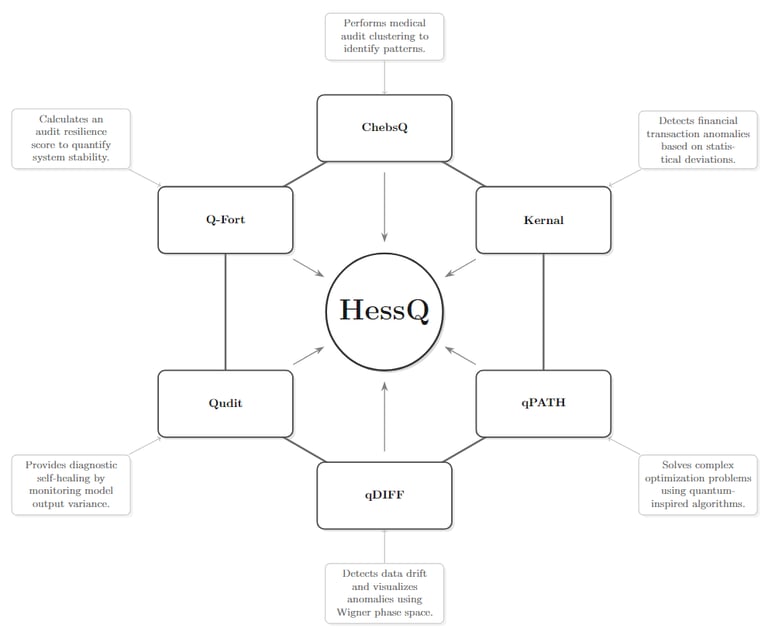
Products
qDIFF




Medical Audit Clustering for Deeper Insights
ChebsQ is the HessQ platform's specialized module for medical audit clustering, designed to bring clarity and insight to complex healthcare data. It goes beyond simple data review by grouping similar medical audits together, revealing patterns that might otherwise go unnoticed.
Key Features:
Intelligent Grouping: ChebsQ automatically clusters medical audits based on common characteristics, such as diagnosis codes.
Data Flexibility: The module is robust enough to handle data even if diagnosis codes are missing, as it can generate random ones to enable the clustering process.
Clear Insights: By calculating the mean of numeric columns for each cluster, it provides a clear representation of cluster centers, giving auditors and administrators an at-a-glance understanding of prevalent audit categories.
This not only enhances the efficiency of medical audits but also provides a robust foundation for strategic decision-making and quality improvement initiatives.
ChebsQ
Audit Drift Detection and Anomaly Mapping
qDIFF is a dual-function module within the HessQ platform, offering sophisticated tools for both detecting data drift and visualizing anomalies with quantum-inspired precision.
Core Functions:
Audit Drift Detection: This function quantifies changes between old and new datasets using symmetric divergence, providing a clear metric for how much your data distribution has shifted over time. This is crucial for identifying systemic changes or gradual corruptions in data streams.
Wigner Phase Space Anomaly Map: This unique tool generates a heatmap based on a Wigner quasi-probability distribution to visualize subtle patterns and anomalies in audit logs. The module also quantifies the "negative probability area," a quantum-inspired metric that provides a numerical score for the level of anomaly detected.
Together, these functions provide a comprehensive approach to understanding and addressing data evolution and integrity issues.








Qudit
Diagnostic Self-Healing for Model Stability
Qudit is the HessQ platform's self-healing diagnostic module, designed to ensure the ongoing stability and reliability of your predictive models and analytical systems. This module continuously monitors the output variance of your models to detect signs of drift or instability.
How It Works:
Continuous Monitoring: By calculating the variance of model outputs, Qudit provides a direct measure of consistency.
Automated Recommendations: If the variance exceeds a predetermined threshold (e.g., 0.1), the module intelligently flags the system, recommending recalibration to maintain accuracy and prevent performance degradation.
System Stability: Conversely, if the variance remains low, Qudit confirms that the system is stable and no intervention is needed.
Qudit automates the critical task of model maintenance, providing a "self-healing" capability that ensures your systems remain accurate and trustworthy without constant manual oversight.
Q-Fort
qPATH
Kernal
Audit Resilience Scoring
Q-Fort is the HessQ platform's solution for quantifying audit resilience, providing a clear and concise measure of your system's stability and integrity. This module moves beyond simply counting anomalies; it translates audit data into a single, easy-to-understand resilience score.
Key Benefits:
Clear Metric: The resilience score is calculated by subtracting the percentage of anomalies from 100, where a higher score indicates a more robust and resilient system.
Performance Benchmarking: It provides a powerful metric for assessing the health of your audit processes over time, helping you to set targets and demonstrate a proactive approach to maintaining data quality.
Actionable Insights: A high Q-Fort score reflects a well-controlled system, while a low score highlights areas that require immediate attention.
Q-Fort empowers organizations to benchmark their performance, set targets for improvement, and demonstrate a proactive approach to maintaining data quality and security.
Quantum-Inspired Optimization for Operational Excellence
Introducing qPATH, the groundbreaking sixth module for the HessQ Master Platform, designed to solve complex combinatorial optimization problems with quantum-inspired efficiency. Extending beyond traditional auditing and anomaly detection, qPATH tackles challenges like the Traveling Salesman Problem (TSP) and other routing and scheduling tasks that are critical for modern logistics and supply chain management.
For businesses, this translates into tangible benefits:
Logistics & Supply Chain: Optimize delivery routes for a fleet of vehicles to minimize fuel costs and travel time.
Manufacturing: Efficiently schedule tasks on machinery to increase throughput and reduce operational bottlenecks.
Resource Allocation: Streamline resource planning to maximize productivity and achieve business goals faster.
Q-Pathfinder is a testament to the HessQ platform's commitment to integrating advanced computational techniques to solve real-world problems. By providing a scalable, quantum-inspired solution for optimization, Q-Pathfinder empowers organizations to move beyond simple data analysis and into a new era of predictive and prescriptive operational intelligence.
Financial Transaction Anomaly Detection
Introducing Kernal, the HessQ platform's robust module for financial transaction anomaly detection, offering a critical layer of security and oversight for your financial data. Kernal is engineered to swiftly identify unusual and potentially fraudulent activities within transaction streams.
How It Works:
Statistical Baseline: The module calculates a rolling mean for transaction amounts to establish a baseline of normal behavior.
Deviation Flagging: It then flags any transactions where the amount deviates significantly—specifically, by more than three times the standard deviation—from this baseline, marking them as potential anomalies.
Proactive Security: This automated approach allows for the rapid detection of outliers that could signal a variety of issues, from data entry errors to sophisticated fraud attempts.
With Kernal, financial institutions and businesses can proactively monitor their data, investigate suspicious activities, and mitigate risks before they escalate.













